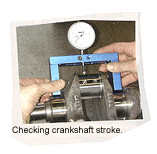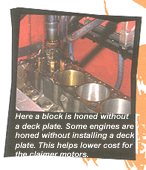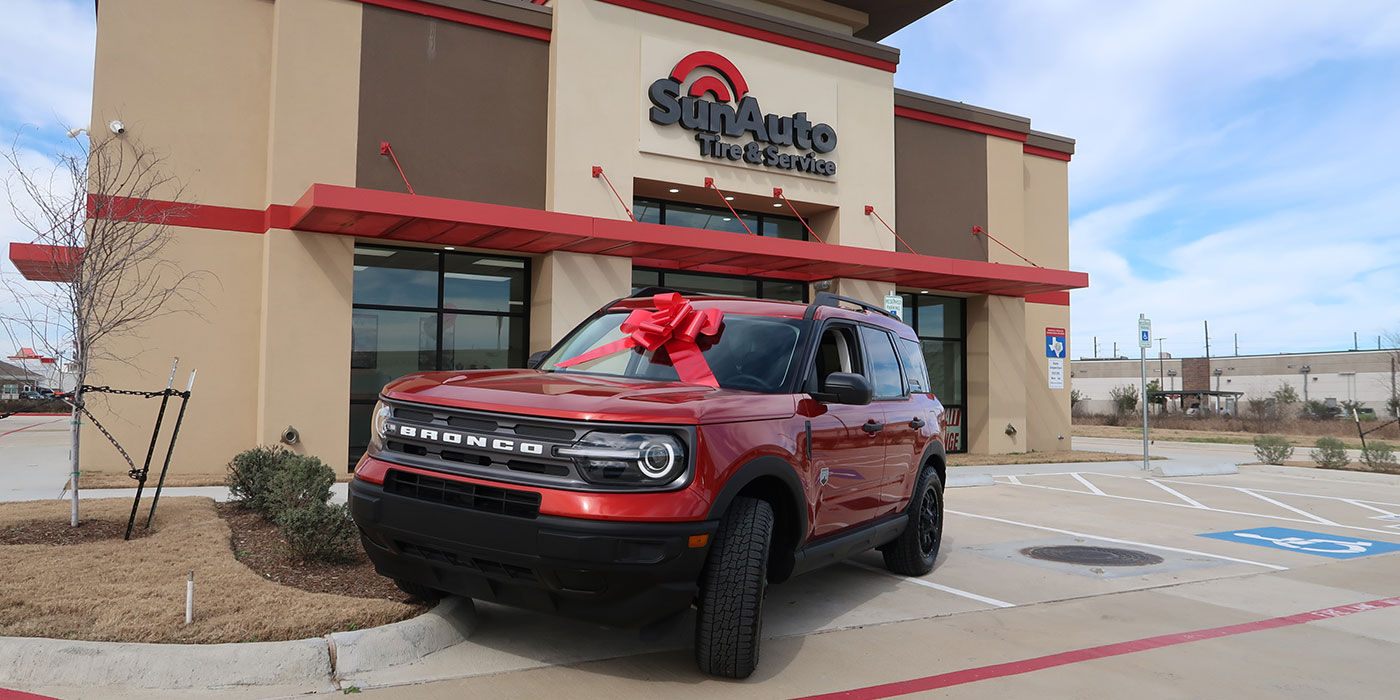If there’s one constant in motorsports, whether at the local short track or the highest echelons of NASCAR, it is the concern over the increasingly high cost of engines. This concern is nothing new – it has been showing itself for as long as there has been any type of motorsport around. In my opinion, this will never change. There will always be someone who will be willing to spend whatever it takes to have the best.
Although there are frequently attempts to control the cost of engines, what most people don’t realize is that the more controls are put in place, the more expensive it gets. There have been some ideas that have helped, and one of these ideas is an engine “claiming” rule.
 The International Motor Contest Association (IMCA) is perhaps the best known sanctioning body to use a claiming rule and it has been very successful in equalizing competition. Although this discussion of claimer engines can apply to most claiming situations, it closely follows IMCA’s program.
The International Motor Contest Association (IMCA) is perhaps the best known sanctioning body to use a claiming rule and it has been very successful in equalizing competition. Although this discussion of claimer engines can apply to most claiming situations, it closely follows IMCA’s program.
Experience is a Great Teacher
Axel Andreasen has been on both ends of the stick. As an engine builder and partner with Bill Davis, Sr. in Iowa, Andreasen had 100 engines claimed in six years of IMCA Modified competition. In that six-year period, Andreasen and Davis seldom raced less than 60 nights each season and found the Winner’s Circle nearly 50% of the time.
They won two IMCA National Championships during that period and during their best season, won 31 races and had 19 engines claimed. According to Andreasen, in 1989 they probably averaged about $750- $800 building each engine. Back then the claim rule was $325 – it’s just recently been increased.
Today, Andreasen is the shop parts manager at JR Motorsports in Ankeny, IA. JR Motorsports is a retail speedshop and has a high performance machine shop. The shop not only has its own line of competition engines, but handles custom work as well. Andreasen explains that whether building an engine with claiming rules in mind or not, most of the machine work is no different. The biggest difference between a low-end motor and a high end is in the components used.
At JR Motorsports, a customer can buy a high performance short block from about $1,100 up to around $6,000 depending on his or her needs or wants. A complete motor ready to drop in can be had starting at around $2,500.
According to Andreasen, a racer can get a really nice piece – the “Pro” Line Stage 2 – for about $5,000, complete. This Stage 2 engine makes somewhere around 550 hp, while JR’s basic engine delivers around 500 hp. The Stage 2 motor is also much more reliable at 550 hp, than the basic engine is at 500 hp. The main differences are in a steel crank and steel H-beam rods, along with forged pistons.
Beware of the Dawg
Federal-Mogul built an IMCA claimer-type motor for its “Big Dawgs” seminar at the Performance Racing Industry (PRI) Show in December of 2002. According to engineers, the cost of that motor with all new parts was around $5,000, not counting the machining and assembly costs. Built with IMCA rules in mind, that motor was ready to drop into a race car – you would need to add the machining and assembly costs to the “Big Dawgs” engine to determine the total cost. Figure a minimum of 30-, up to about 60-man hours, in the machining and assembly time.
The Recipe for Success
Like many motor rebuilders, JR Motorsports starts with a quality core purchase. All Chevrolet 350 and 400 engine cores are subject to careful inspection and often disassembly before purchase. Andreasen says it’s important to pay close attention to the quality of the core. Of course, you could also start with all new parts including the block. Regardless, most of the prep items will apply to both.
At JR Motorports, the block is initially baked, shot cleaned, hot tanked, then inspected again. Once it clears the core room, inspections and cleaning, it is time for race prep of the block. In most cases, you can skip some steps with a “claimer” that you wouldn’t skip for other high performance engines.
The oil passages are redrilled, and at JR Motorsports that means slightly oversizing them to supply a little more oil, and to remove any rust and oil sludge that may have built up. This was also done with the “Big Dawgs” block where a 5/16? drill was used for the main oil passages.
The next step is align honing to true up the main bores, which in turn ensures that the deck can be properly squared off the main bore. Following the decking procedure, the block can then be bored and honed. This includes correcting the bore angle which can be off as much as .008?-.012? for a small block Chevy. At JR, specs call for a piston clearance of .0025? to .0035? with Federal-Mogul pistons.
Although the “Big Dawgs” motor used steel main caps they may not be necessary in all cases. At JR Motorsports, the rule-of-thumb is that under 500 hp, a two-bolt main block will be OK and above 500 hp, four-bolt mains should be used. Andreasen says his shop will generally try to use a 4-bolt core using the stock caps, which for most “claimer” motors is sufficient. Steel caps are an option.
When honing the cylinder, proper finish is important. A rougher finish will allow the rings to seat sooner, while a smoother surface will prevent a change in your ring gap. This also depends on the break-in procedure and your experience should help guide you. At JR, a smoother finish will be used if the motor will be broken in on the dyno. According to information from Federal-Mogul, the correct cross-hatch, 42 degree bisecting angle allows the proper lubrication and ring rotation. A finish of 10-15 Ra is recommended.
Off the Shelf
A note about the “claimer” type shelf engines: although bore angle is corrected, bore center spacing isn’t. And when honing, at JR Motorsports, 400 blocks are torque plated because of their higher value (and thinner cylinder walls), while 350 blocks are honed without a plate, unless forged pistons are used. This is just another area for a cost savings.
Because the stock main caps are used for most shelf claimer motors, honing is the only requirement. If you are installing steel caps, of course, you would need to align bore the block prior to align honing.
JR Motorsports will install a steel front cap if a gear drive is used, because a gear drive tends to push down on the front of the crank, whereas a chain drive pulls up on the front of the crank. Again, horsepower levels determine many of the components used.
Steel main caps were installed on the “Big Dawgs” motor, but regardless of the type caps, the main bore should be honed to 2.641? on a 350 block and 2.841? on a 400 block. This will ensure proper bearing crush, and will also allow for good heat transfer from the bearing. The cam journals were also align bored and honed in the “Big Dawgs” motor to a finish of 2.030? and used Sealed Power 1750M cam bearings. The oil grooves in the cam journals were also enlarged by hand using a boring mandrel.
The type fasteners that will be used are also determined by horsepower and components used. At JR’s, the basic claimer motor (the “Classic” series) uses hypereutectic pistons and stock rods as well as stock GM bolts for the caps. The “Pro” series Stage One that uses a forged piston and Scat I-beam rods comes with ARP bolts as main cap fasteners. The Stage Two and higher engines all use studs on the main caps. The “Big Dawgs” engine came with studs for the main caps.
Crank choice also depends on horsepower or customer preference. JR Motorsports’ “Classic” series engine uses a performance reground stock crank. Moving up to the “Pro” line Stage One gets a customer a Scat cast steel crank. Stage Two and beyond engines come with a forged steel 4340 crank.
Balancing the crankshaft, as well as the rest of the rotating assembly, pistons, rings, rods and bearings is needed for best performance. Regardless of what crankshaft you use, you will need to do several things to prepare it. If you are using a stock GM crank, you will want to at least regrind it.
According to Andreasen, stock GM cranks are very good and he is comfortable with them in applications up to 500-550 hp.
He says that the heat cycles that the cores have gone through in the past play right into your hand because they will be harder than when new. His shop tries not to grind them more than .010?, but has gone as much as .020?. Andreasen is confident that when that crank comes off the grinder it will be perfectly straight.
Any engine that would utilize a 3.480? stroke crank in the “Classic” line of engines uses a stock GM reground crank, those using a 3.750? stroke get a new Scat cast steel crank. The “Big Dawgs” motor utilized a Scat crank with a 3.750? stroke.
Pistons, Rings and Rods
At the minimum, you will want to use a hypereutectic piston. At JR’s, Sealed Power hypereutectics are the baseline piston in the “Classic” line of engines. The “Big Dawgs” engine uses Speed Pro Hypereutectic pistons.
 Other pistons can be used, of course, depending on customer needs. Many styles are available such as flat, domed, reverse dome, etc. Keep in mind that flat top pistons are believed to be the most efficient and would be the best choice, provided you can get the compression ratio you want.
Other pistons can be used, of course, depending on customer needs. Many styles are available such as flat, domed, reverse dome, etc. Keep in mind that flat top pistons are believed to be the most efficient and would be the best choice, provided you can get the compression ratio you want.
There are many good options available in ring packs. A moly ring should be considered the minimum. While cast rings are cheaper and do a good job, Andreasen says they just don’t seal as well as the moly rings. He feels that the moly rings start out with a better seal than the cast rings obtain after broken in. The moly rings will also last much longer.
Opinions do vary slightly on ring gaps. A .017? gap on top and a .019? gap on the second ring was recommended in the “Big Dawgs” motor, while JR’s recommends .020? on top and .018? on the second. After installing the rods and pistons in the block, check your rod side clearance, looking for a .018? – .028?.
For rods, once again you can start with a stock rod and move up from there as horsepower needs require. You will want to shotblast and magnuflux the rods if they came out of a core. You should also resize them with new ARP or another performance option. However, with the cost difference of less than $100 per set, you may want to go the aftermarket route.
The “Big Dawgs” motor utilized Scat I-Beam rods. At JR’s, rod choice is determined by engine series or customer preference. The “Classic” series will start with stock, reconditioned rods, while the “Pro” series Stage One will move up to the I-Beam rod. All Stage Two and above motors will use a steel “H” beam rod.
On new connecting rods, JR’s will remove the cap and run it across 600-grit paper on a granite plate. The cap is then reinstalled and the rod bolts are stretched to proper strength, then the rod is honed to the correct size. They are finished to 2.225? on large journal rods, and 2.125? on small journal rods. JR’s Andreasen says you shouldn’t skip this step because of the importance of proper bearing crush. Piston pin clearance should be .0008? on press pin rods, and .0005? on full-floated rods.
Once the rods are ready, you can install the bearings and torque the caps to check the clearance. You also need to install the main bearings, torque the caps and check the main bores. Also measure the crank journals to determine proper clearance. On the mains, JR’s recommends .0025?-.003?, depending on the engine, and .0022? – .0026? on the rod bearings. The “Big Dawgs” engine had main bearing and rod bearing clearances of .002?. Crankshaft endplay was .004? on the “Big Dawgs” motor; JR’s recommends .004? – .010?.
Heads Up
Head choice is somewhat limited by IMCA rules, but the “claim” rule also limits what drivers are willing to spend on heads, because if the engine gets claimed, the heads go with it. Steel heads are specified in the IMCA rules, but a builder has many to choose from. The “Big Dawgs” engine got a pair of Pro Action 23 degree Iron Lighting heads from L&M Engines. These heads feature a 220 cc intake runner and were surface milled to produce a 64 cc chamber.
Other heads are available, and at JR’s, options start with GM OE castings, and upgrade to GMs “double-hump” castings. The “double-hump” castings are getting harder to come by, however, and may not always be available. Andreasen says aftermarket choices include World Products “Sportsman II” or Dart “Iron Eagle” heads as the most popular, and each come with a choice of chamber volumes.
The same Pro Lighting heads used on the “Big Dawgs” motor are also available from JR’s. One nice thing about these heads is that they are also available in a “small chamber” configuration. The “Big Dawgs” head worked out to a compression ratio of about 13:1; with 72 cc chambers that would have given just under 12:1; with the small chamber heads at 50 cc it would have been about 16.5:1.
Of course, there are other things you can change to achieve a desired compression ratio, such as bore and stroke. Even head gasket thickness will change it one way or the other. I wanted to show you what differences just the heads could make, but keep in mind that high performance engine design takes into account many other variables.
When the “Big Dawgs” engine was placed on the dyno, the first pulls were done with 1.5 ratio rocker arms. The second time around 1.6 ratio rockers were tried. With the 1.5 rockers, the engine topped out at 471.2 ft.lbs. peak torque at 5,000 RPM and 470.9 peak horsepower at 6,000 RPM. With the 1.6 rockers, the engine had 485.8 ft.lbs. peak torque and 484.3 peak horsepower.
Final Notes
When finishing the assembly of the engine, you’ll find numerous choices for intake manifolds and carburetors. And always remember to check all your clearances.
We’ve tried to cover what is involved in building a “claimer” motor, and show you different ways to build them. Obviously, there are some things we didn’t discuss, such as intake port matching, cylinder head assembly, degree of the cam, etc. And because there are too many variables, we aren’t going to get into camshaft selection. However, if you need more information on these topics, visit your local engine building shop or a performance speed shop. Or contact an engine parts supplier. They should be able to forward you to helpful engine building professionals or technicians in your area.
Your instructor, too, may be able to give you some helpful pointers when building a claimer or other performance engine.
Your own claimer engine needs will vary and will depend on many factors. Sometimes you will want the lowest cost motor you can get, other times you may want the best. Most often, you will choose something in between. Only though experience can you create the best combination that’s right for you or a future customer.



